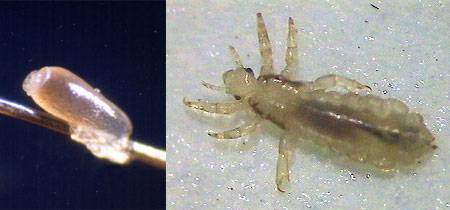Head Lice - And how to get rid of them!

What are head lice?
- Head lice are tiny, wingless insects – they cannot fly, jump or swim, but they can walk;
- A fully-grown head louse is similar in size to a sesame seed
- Louse varies in color from light brown to dark red –nit is seen as a small glistening speck attached to hair shaft which can only be removed by pinching fingers above it and sliding it off the end of the hair;
- Can’t survive the cold – so clings to hair, keeping close to the warmth of head.
- Found mostly behind the ears and at the nape of the neck
Life cycle of head lice
Louse has three stages, which last 1 month from egg to egg:
- Nits – are the eggs laid by the adult female louse; they are attached to the hair shaft by strong cement close to the scalp, because they need body heat for incubation.
- Size – 0.8mm x 0.3mm
- Shape -Oval
- Color – Yellow / white
- Location – Within 6 mm of the scalp
- Life-length – Nits take 6 -9 days to hatch.
- Nymphs –released when an egg hatches. The nit shell stays attached to the hair and turns a dull yellow color. The nymph looks like an adult louse but is smaller. As the nymph grows, it molts out of its exoskeleton 3 times before becoming an adult.
- Size -Variable but about the size of a pinhead
- Shape – Same shape as the adult louse
- Color – Yellow to rust-colored
- Location – Close to the scalp, especially behind the ears and at the neckline
- Life-length – Nymphs become adults after about 7 days
Adult: The adult louse feeds about 5 times a day by piercing the skin with its claws, injecting irritating saliva, and sucking blood, which gives them a rust color. Head lice hold onto the hair with hook-like claws found at the end of each of their 6 legs. Adult lice are active and can travel quickly.
- Size -The size of a pinhead. The female louse is larger than the male.
- Shape – Oval with 3 legs and claws at the end of each leg
- Color – Rust
- Location – Close to the scalp, especially behind the ears and at the neckline
- Life-length – Adult lice can live up to 30 days on a person’s head
- Reproduction – An adult female can lay up to 8 nits per day
Who gets head lice?
Head lice can affect anyone with hair – long, short, dirty or clean hair – they are not a sign of poor hygiene. However, children tend to be most affected;
How do they infect a person?
Lice travel by head-to-head contact and walk from the hair of an infected person to the hair of someone else
Head lice can be picked up by direct contact or by sharing combs, brushes and hats – often whole families are often affected. The adult louse can survive up to 1-2 days without feeding on the scalp and can therefore transfer from objects that have been in contact with an infested person, for example:.
- Clothing – hats, scarves, coats, and sports uniforms
- Hair care items – combs, brushes, towels
- Soft objects – pillows, beds, carpet, stuffed animals
Head lice symptoms
- An itchy scalp is the main symptom of a head lice infection. Also the sensation of something moving in the hair;
- Lice and nits in the hair. Nits are the eggs or empty eggshells after the lice have hatched. Warm areas behind the ears and the nape of the neck are favorite dwelling areas;
- Sometimes tiny red spots are seen on the scalp. Usually caused by scratching;
Quick, easy, cheap method to get rid of head lice
Here’s how to get rid of these pesky critters
Even works on long hair!
Do not combine this method with bought lice removal products – the vinegar negates their effect
- Dampen whole head of hair and scalp with white vinegar
- Thoroughly rub baby oil (or any type of mineral oil) into hair and scalp –~1/2 cup is sufficient for average hair length. Make sure all strands are coated with oil
- Cover your head with a shower cap – I’ve actually used plastic shopping bags tied tightly onto the head without air-pockets. OK -so I suggest you don’t visit with the neighbors whilst sporting your new head attire
- Leave on your head for an hour –this should suffocate the lice;
- Use nit comb to remove all nits and dead lice – vinegar loosens their hold on the hair shaft; bang them out of comb onto a piece of white paper to see your “finds”
- Wash your hair with a normal hair shampoo
You can optionally repeat process in a few days – to catch any lice / nits that may have “escaped the treatment”.
Added benefit – treatment conditions hair making it feel nice and soft;
Clean the house thoroughly
- Vacuum –carpets, pillows, mattresses, over-stuffed furniture, car seats;
- Wash / Dry –bed linens, towels, recently worn clothing in hot, soapy water in a washing machine. 140 degree F dryer kills both lice and nits;
- Non-washable items –place in freezer overnight or store in tightly sealed bag for 2 weeks
- Soak combs / brushes 15 minutes in very hot water – a good idea is to buy everyone in the household their own personal comb and brush.
- Instruct children not to share combs, brushes, hats or other articles of clothing at school, play or other activities












